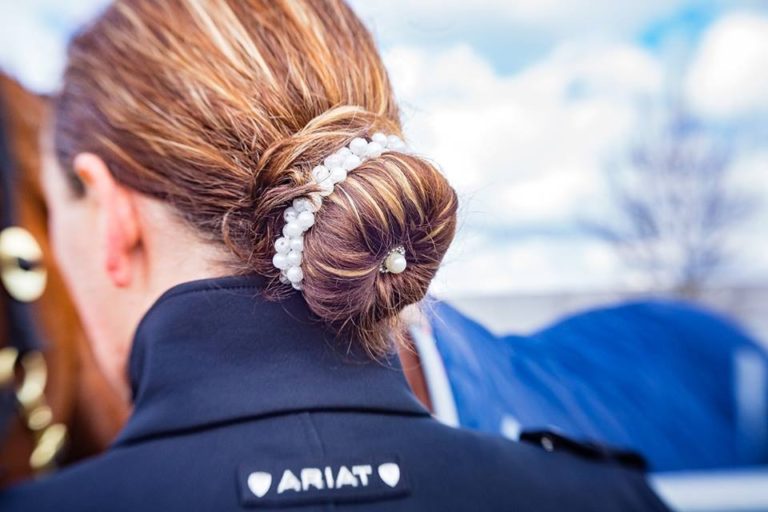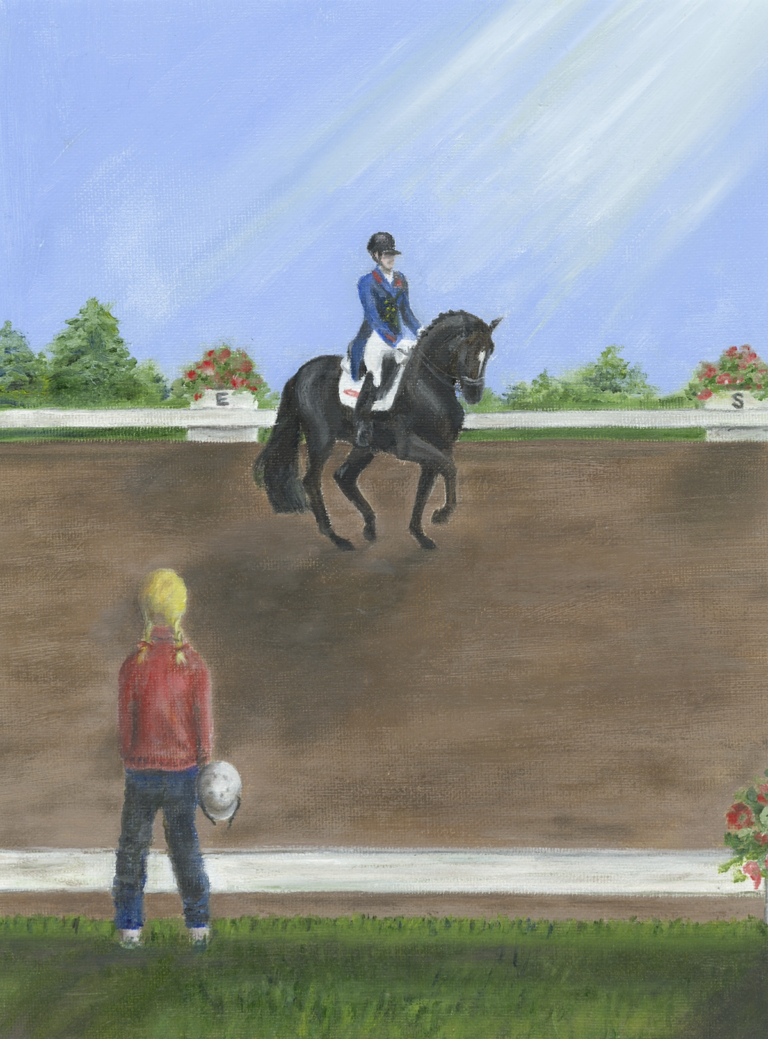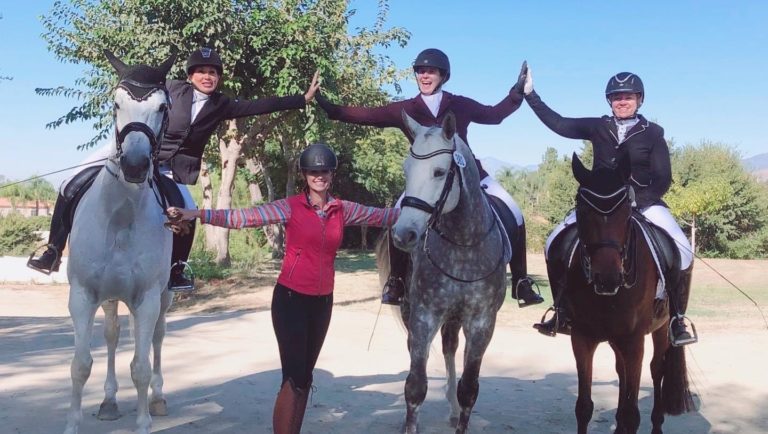Heather Sansom is the author of rider fitness ebooks Complete Core Workout for Rider, and a regular columnist in several equestrian publications including Dressage Today.?EquiFITT.com offers rider fitness clinics & workshops, Centered Riding? instruction, and convenient distance eCoaching for riders anywhere.? Subscribe to receive free monthly Equestrian Fittips, and download rider fitness eBooks at:??www.equifitt.com/resources.html
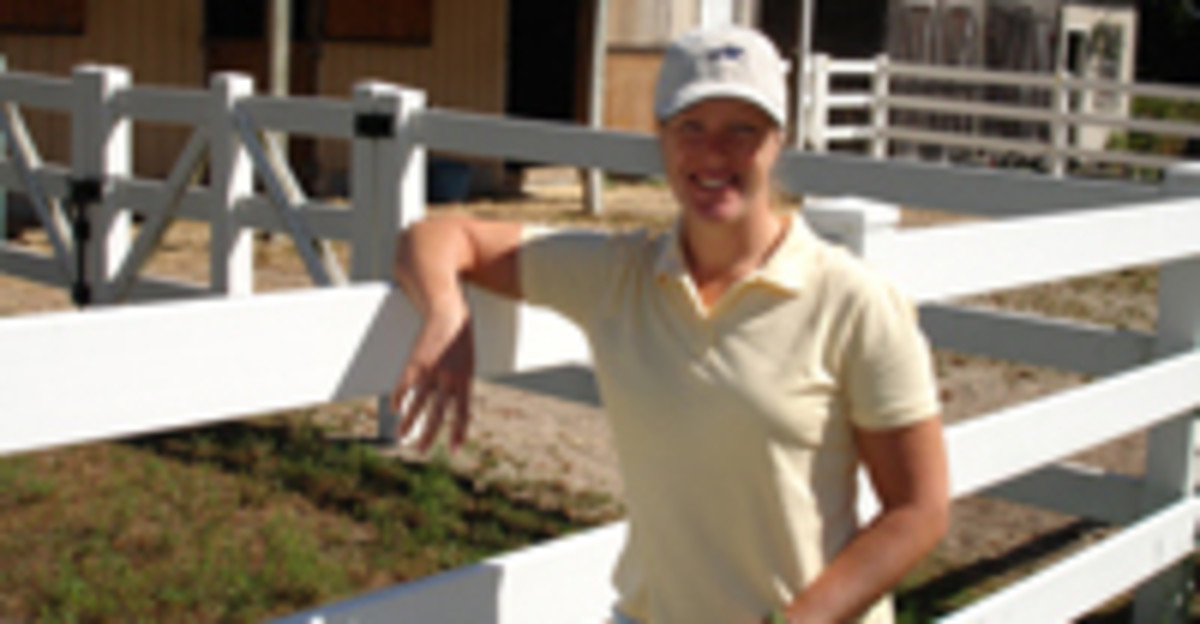
In last month’s article we discussed the importance of maintaining symmetry in motion, and some of the biomechanics that go into creating a fluid stability you need as a rider.
In other articles, I’ve talked about the rider fitness training scale and the concept of responsive relaxation to help guide you in making efficient use of your cross-training time. There can sometimes be a gap between ‘getting’ an idea on the ground, and actually applying it in the saddle. We know most of the top athletes in any sport, including equestrian, engage in cross-training activities. To help illustrate this, I had the opportunity to interview FEI coach Eddo Hoekstra for this month’s Fitness Tip.
Eddo’s approach to training the rider parallels his approach to training horses. Both use exercises to create gymnastic balance, which then becomes the base for more advanced work in harmony and in accordance with the training scale. Even more importantly, balanced training of both horse and rider results in reduced wear and tear, reduced risk of injury and a longer performance lifespan. Training for the rider is so important because we’re sitting on our horse, affecting his movement at every step with the way we’re using our body–voluntarily and involuntarily.
Eddo maintains his own cross-training program with personal trainer Dereck Farr at Nubodies Fitness in Peterborough, Ontario, Canada, and a fitness travel regimen when he’s on the road.
Interview
Heather: What types of cross-training activities do you use for riding?
Eddo: When I’m home, I go to the gym twice a week for personal training sessions, which focus mostly on strength and conditioning. If I miss a workout because I’m traveling, I make it up by working out at home or while I’m away. At the gym we do weights, stretch and a little bit of running for a warm-up.
The nice thing about working out with a personal coach is that you get the most out of your workout because they keep an eye on your technique, push you a little more, see if you should do more/less and keep tweaking the program.
When I’m spending time by myself, I go to work on the areas I feel I should be working on, or just do an overall body workout to make sure I’m supple.
Heather: What made you aware of the need for cross training as a rider?
Eddo: When I was younger I did a lot of judo and martial arts. But then I got busy with my riding. When I was in Bermuda, I met Robert Dover. He invited me to train with him, and I would go for a week in the spring and a week in the fall. He got me started going to a gym regularly. He has always been serious about fitness and suggested I get started. So I joined a gym in Bermuda and it really made a big difference.
Beyond normal fitness, I felt I could do everything I did before, but a little better and easier. When coaches came for clinics, they really noticed a difference in my riding. When you’re fitter, you’re much more relaxed and your coordination improves because you’re much more stable.
Heather: As far as the physical demands of riding, what changes have you experienced physically over the years?
Eddo: In Bermuda I had a really active lifestyle–working out five days a week, waterskiing and swimming on the weekends. I was also young, with time on my side. I didn’t really have to think about being active. In Canada I didn’t have any of those things.
I tried to get involved in martial arts again, but the time commitment conflicted with my riding and training, so I couldn’t maintain it. But your body ages on you. Even though I was active riding all the time, I came to a point where I wondered how I could go on with my knees cricking and cracking and lifting a bale of hay without my back hurting. I just got so busy with my job that I forgot about maintaining my fitness level. Then, about five years ago, I started going to a gym.
Now I can unload wagons of hay and my back and knees never bother me. It’s so important and has to be part of my life. We have staff to do most of the chores, but when I need to help out, it’s important that it doesn’t create problems for my riding. I also ride better when I’m fit.
Your body needs time, too. You can’t just make it work like a machine without maintenance. You need TLC. The right exercise makes your body supple and allows your body to do its job easier without wear and stiffness.
Heather: How to you use cross training to address specific issues?
Eddo: We get one-sided when we don’t pay attention to building symmetry and balance in our own body. Riding does not necessarily create that symmetry, because your body will do what it wants to. My right hip flexor would be a little tight and hurt. That was a sign of one-sidedness. It would make my right leg creep up as I was riding. I’m right handed, so any barn work would tend to reinforce unbalanced strength on the right side. Exercise has made me more conscious about balance, and I make smarter decisions, like using two pails when I lift water so I’m balanced.
To correct one-sidedness, you have to be vigilant when you’re riding and resist the tendency to lean or use one side more. I also stretch out the right side a little more, especially the hip flexor, using a runner’s lunge.
In my workout, the emphasis shifts depending on what’s needed at the time. It’s not important to have big muscles, but is important to be very strong in your core, have good core control, be supple and even and relaxed so all the muscles can do their job properly without tightening up. If you have good muscle tone, your body can relax more when you’re riding, allowing things to happen. If you’re tightening up or trying too hard, you will restrict your horse’s movement.
Heather: What areas are important for riders to focus on in their cross training?
Eddo: Anything you can do to develop independence and carriage from the waist up makes an enormous difference. An example would be doing lunges with weights–keeping your sternum up and maintaining your correct upper body posture through the exercise. Stability of your upper body is very important. The way you carry yourself while your horse is moving under you makes an enormous difference in how the horse can balance, because he balances himself according to the riders’ balance. You don’t need that much strength to ride. A lot of times the horse and rider struggle because they’re just not in balance together. Most people are too busy and want collection right away. Start with your own carriage and balance, with yourself being connected to the horse so your first step is already connected.
I like talking about different sports because most people don’t think enough about it. They think about controlling the horse, but the feeling of control is something that happens as a result of the decisions you make. When the rider initiates a thought and the horse responds, then the rider immediately follows the way the horse moves. The moments they come together are the moments that feel “in control.” The control is created out of your ability to stay mentally and physically focused and balanced, reading your horse, knowing what to adjust and being able to do it.
A combination of all your aids has a suppling, straightening, strengthening effect on the horse, so he feels ready for whatever comes up. In that moment you feel you could do just about anything. This comes from not doing the same thing too many times. The same things that apply to our horses, also apply to us. If you do one thing too many times, the same muscles get used and you are no longer gaining anything. You’re creating one sidedness. So, just like you need to mix in exercises that have a suppling and strengthening effect for your horse, you need to do the same for yourself. Get your muscles working differently in the week. You can use all kinds of things for cross training as long as you know what you’re aiming for (for example, are you increasing your suppleness or symmetry, or building endurance).
Don’t over train. If you want to repeat an exercise, go do something else, then return to it later. The way you train yourself and your horse is the same. There’s a physical and mental disadvantage of staying stuck in the same activity. Rather than trying to produce the big picture, train the pieces that make the picture, then start putting it together. If it’s not quite working, take it apart again and keep working on the pieces, then putting them back together. You can always go back to something simple that has a suppling and straightening value. In the process you improve the skills that will allow you to carry off the big picture when it comes together.
Heather: We know it’s important for riders not to have bulky, bound muscles. Why do you choose some of the strength training exercises you do?
Eddo: Whatever your activity, you should become strong so you can stay relaxed. Muscles that are not strong hit their limit, and then start to strain and become tight, blocking the motion of the horse. If you’re conditioned, you should not need pain relievers for muscle soreness after riding. A lot of riders are trying to do the work instead of their horse. You’re more like the team manager. A good team manager doesn’t try to do the players’ job. Your job is to initiate things you’d like him to do and let him respond–then you need to be able to follow. You’re constantly responding to feedback and adjusting. When your muscles are straining, this becomes difficult.
Heather: Is there anything you wish you had known earlier in your career with regards to your athletic training? Any advice you would give riders to develop as athletes?
Eddo: I think it’s so important for younger riders to get some help with exercises to make themselves more supple so they have a head start. Don’t wait until you realize you need it. We have some great role models: Betsy Steiner, Robert Dover and Steffen Peters are good examples of athletes who take their cross-training seriously. Most top riders do some form of cross training.
The most important thing is to enjoy yourself and have fun. Kids should do something because they’re doing it for themselves, not the parent. During my coaching with young people and clinics I make references to different sports because when you’re riding you have to balance yourself, and you can learn things from other sports like gymnastics and martial arts. The key to riding is balance and being able to maintain independent balance, as the horse shifts under you–like being on a surfboard.
You start off in the shallows learning to balance yourself. You work with the energy, not against it. When you’re comfortable, you move to bigger waves and wind until you can manipulate the board and still maintain balance and control against outer forces. Then you can take on more. As long as you stay grounded in the basics, you’ll be able to maintain a good level of quality control when you move up.
Exercises Eddo Uses
I really like Eddo’s training program because a majority of the exercises use multiple joints and movement on multiple planes. As riders, we’re always in motion in four planes, which can be a little different from other sports. We also have the unique problem of needing to balance on seat bones, rather than from our legs or feet.
Because balance is so important, many of Eddo’s exercises are designed to challenge the body’s balance, engage core stabilizers and develop the brain’s ability to separate what is required in the upper versus lower body. It’s easy for the torso to get out of balance front to back because most of general life activities–barn work and riding included–have us engaging muscles in the front of our body. This imbalance can create difficulties with posture and self-carriage when riding, so a good cross training program includes work for the back. Here are some exercises:
Medicine Ball Plank & Bosu Pushups: Pushups are an exercise that work your whole body at once because doing them correctly (slowly and with correct posture) forces you into a moving plank position. Even if you can only do them by moving a centimeter, there is still value in the exercise. Pushups on a balance object, such as a bosu, work your core significantly more because you are forced to stabilize your body. You could also use a big cushion, a balance board, a basketball, medicine ball, a board over a pool noodle or other destabilizing object. To keep the plank position, lengthen your whole body imagining you are pushing your heels and top of your head as far away from each other as possible. Pull up your stomach and tuck your tailbone down to take the dip out of your lower back. This will force you to work on the lumbar area muscles as they create a stabilizing ‘bridge’ similar to the muscular development you want in your horse. This muscle area in particular is one of the biggest factors in maintaining posture in the saddle.
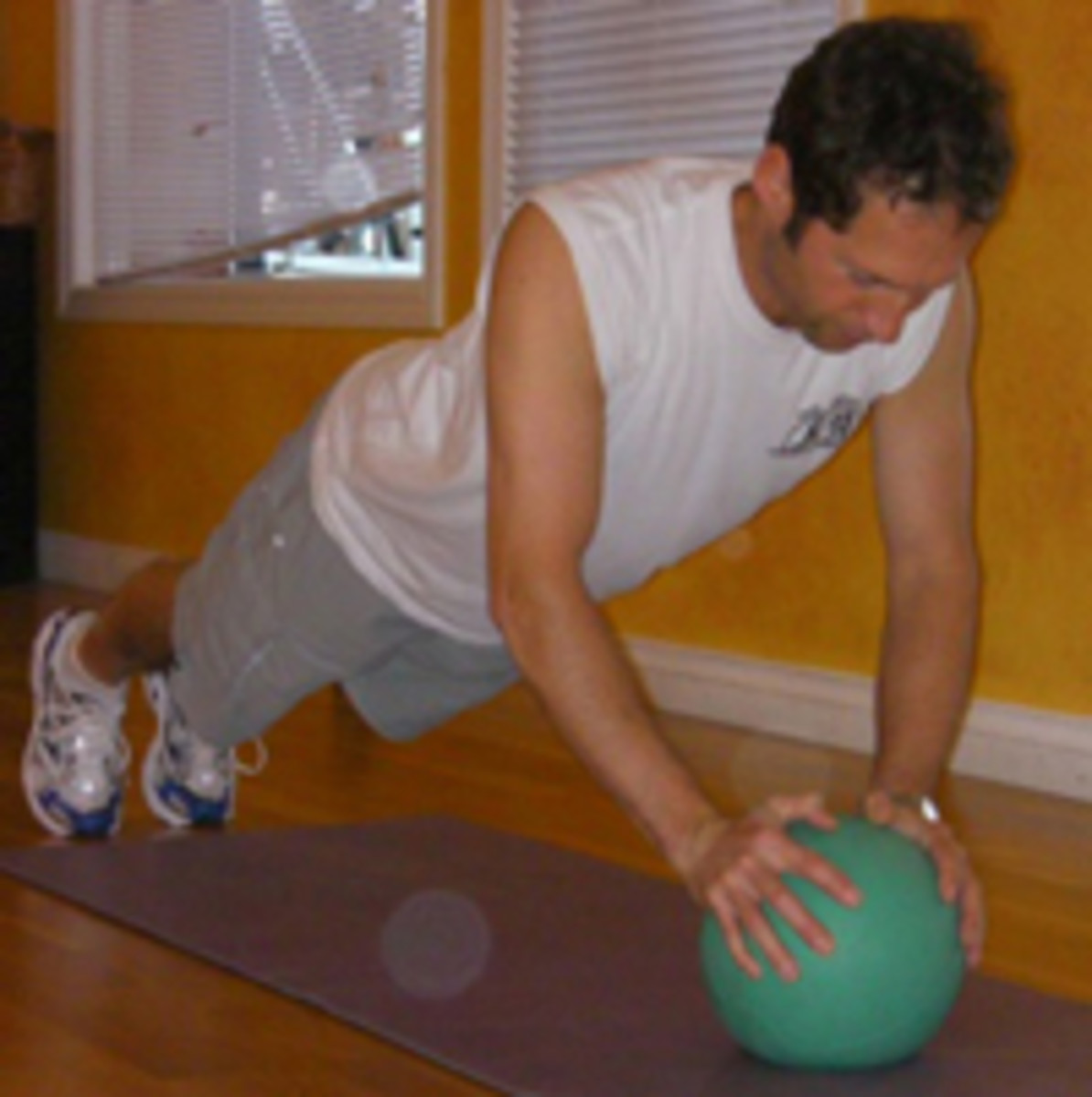

Chest Stretch: It’s important for riders to stretch chest area muscles on a daily basis to keep the chest open and prevent a forward and down tendency of the shoulders. When you work that muscle area either through exercise or barn chores or other activities, stretching is doubly important. Eddo is using the wall to hold his hand in place while twisting away to lengthen the pectorals. You can use a doorway as well.
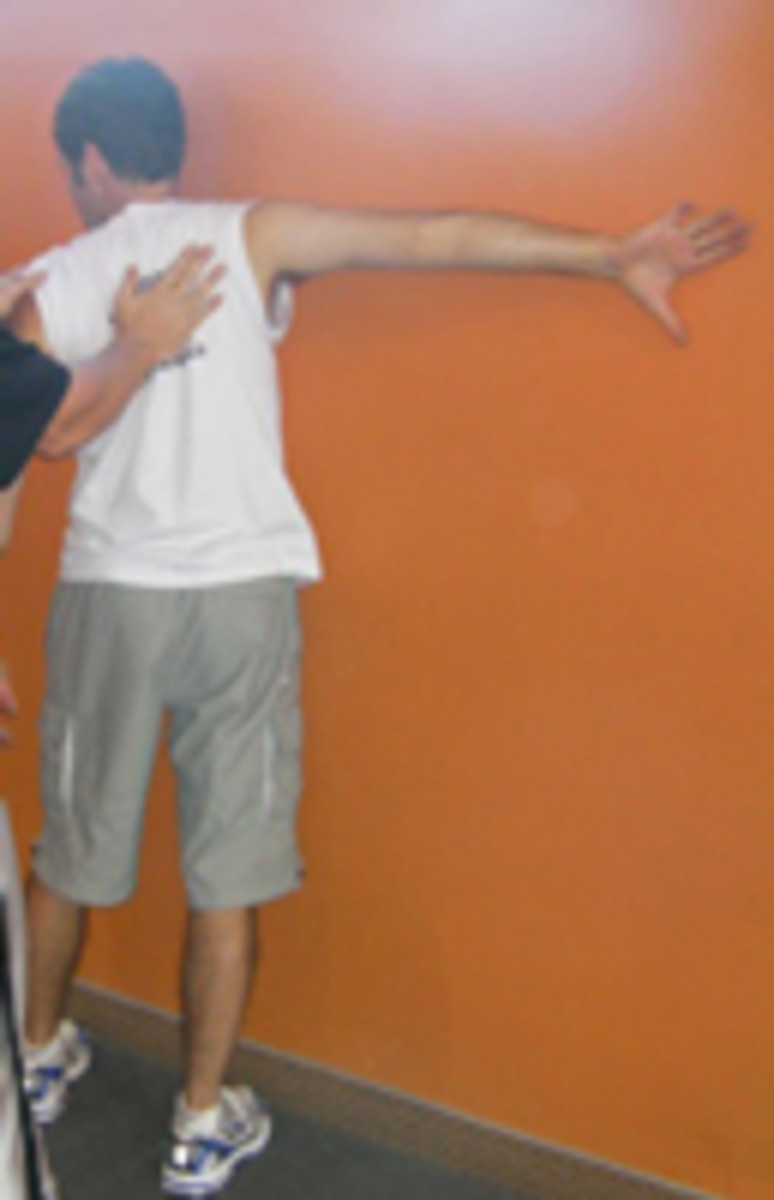

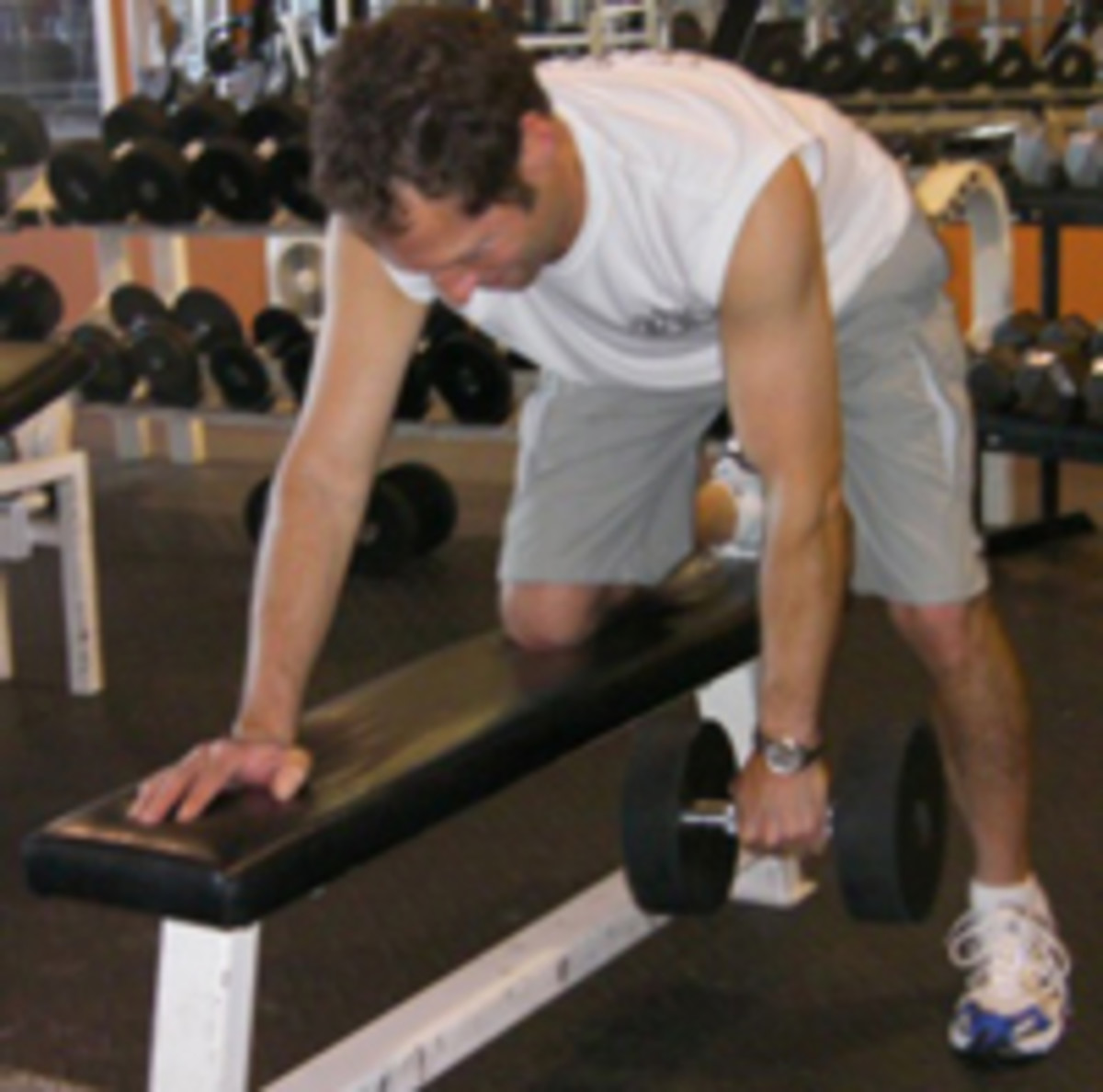
Single Arm Row: Any exercise in which you contract your scapula (bring them closer to each other, or closer to your spine) with resistance will strengthen your lower trapezius and rhomboid muscles. This is a very important muscle group for riders. There is very little in daily life that forces us to strengthen this area, and it is engaged very little when riding. This is partly why people’s shoulders tend to pull forward. Strengthening the area balances your torso structurally, and helps you sit straight without having to think about it. It also helps you engage your shoulders while riding, without your body having to compensate by cheating with your upper neck/shoulder area muscles (which pulls shoulders up and causes tension in the neck/shoulder area).

Seated Medicine Ball Catch: This is a very challenging core exercise that combines the unstable surface of the bosu, with the task of catching a weighted ball and maintaining your balance against the force created by the ball toss. You can also do this exercise sitting on a balance board, balance cushion or big cushion. You can also recline against a fitness ball for an exercise with similar effect. The exercise brings value to a rider, because as in riding, you are not stabilizing your body through your legs.
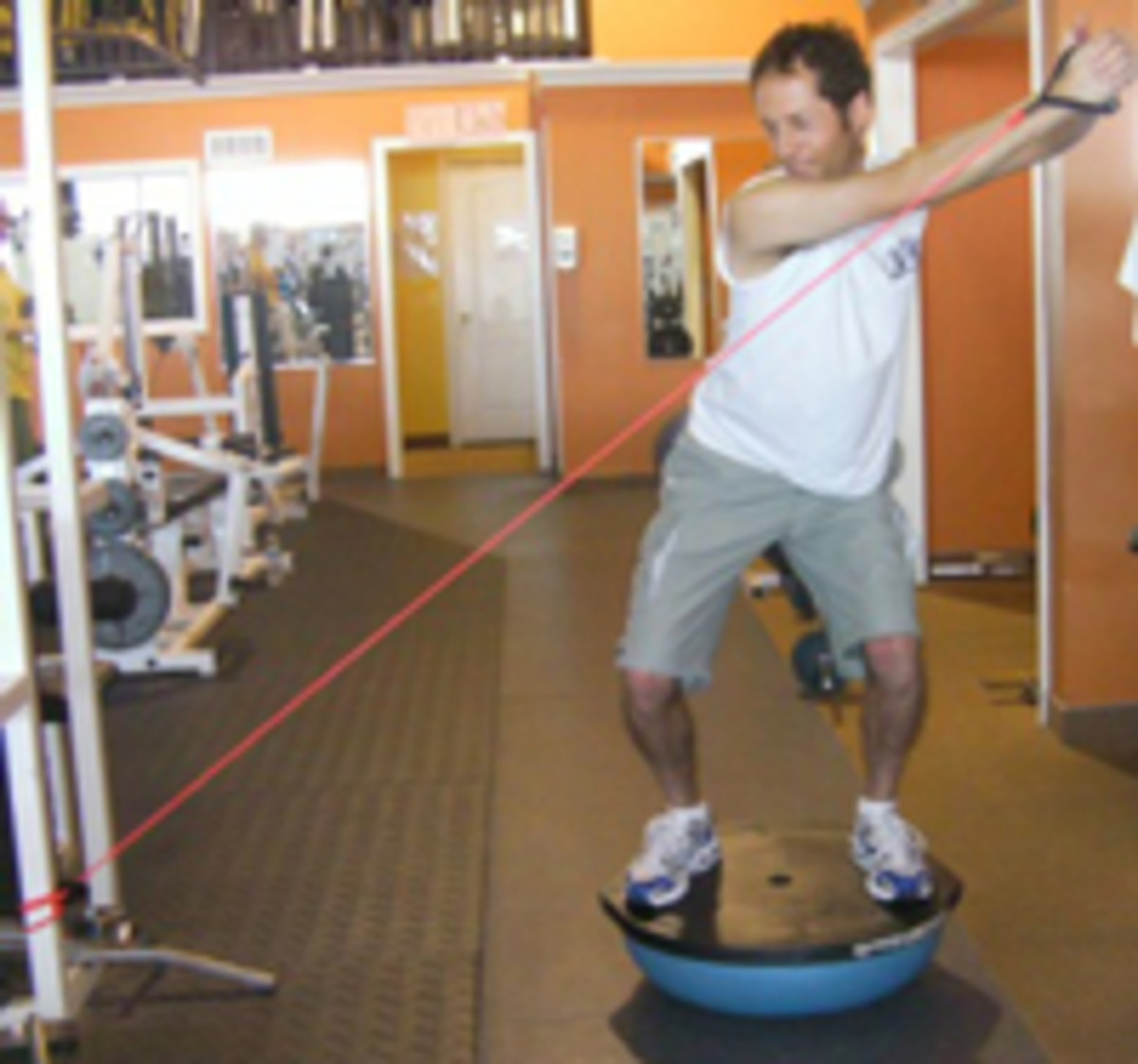
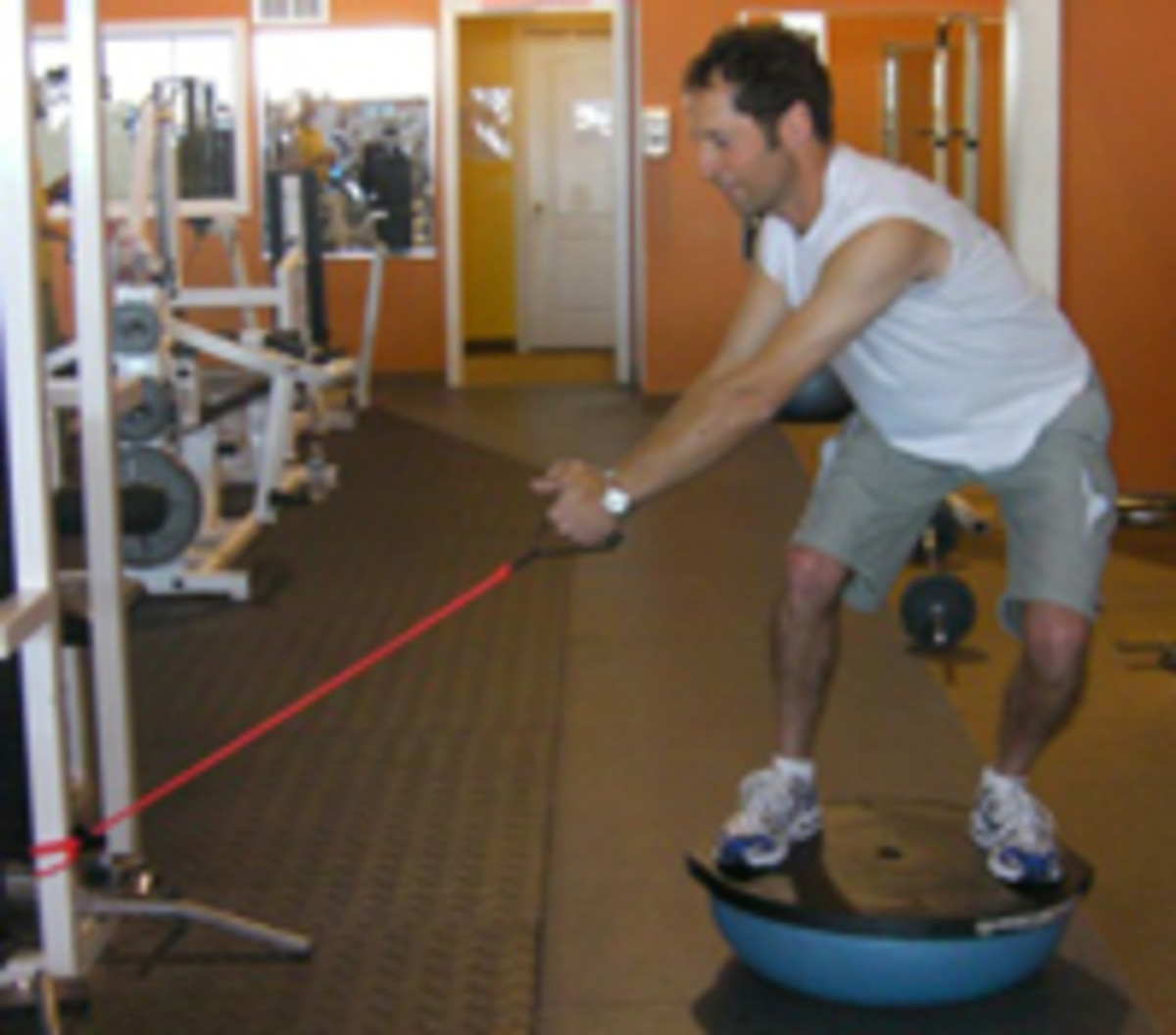
Upward Chop on Bosu with Resistance: I just love this exercise and get clients to do exercises of this type frequently. There are many complex components in this particular one. First, the bosu creates instability for the lower body. Secondly, the act of pulling upwards uses the back and shoulder muscles in exactly the opposite direction from the way we usually use them (down). Upward exercises help your body’s ability to hold itself up. Third, standing on an unstable surface AND doing a weighted upward motion engages almost every muscle in the body, but especially the core for stability. Fourth, Eddo is also introducing a rotation that makes the back, obliques and gluteals work really hard. The exercise would already be difficult to do correctly standing on the floor.
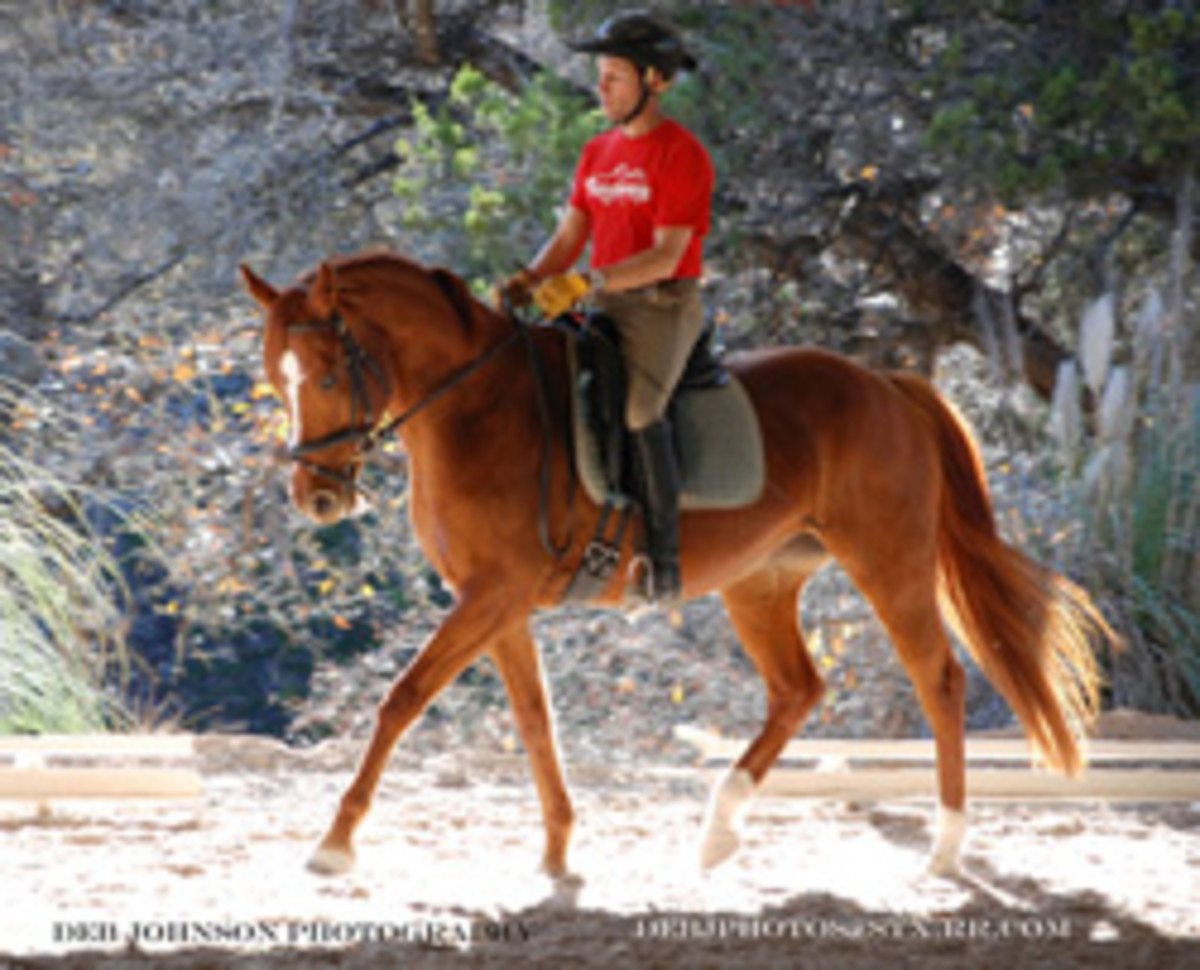
Born in Holland, Eddo Hoekstra started riding at the age of nine and later moved to Germany in his early twenties. Here he completed his German riding degree–Bereiter FN with the German National Federation–while training with Rick Klaassen former coach for the Dutch Dressage Team. After receiving his Bereiter designation, he taught riding in the cavalry in Germany for the Dutch military, and then accepted a position as riding coach at Spicelands Riding Center in Bermuda where he taught for six years before moving to Canada. After moving from Europe, Eddo has trained with Jan Kluijtmans, Robert Dover, Betsy Steiner, George Williams, Eric Lette and others. Today, Eddo holds an International Coaches passport, Level 2, has competed internationally at the FEI level and has been working with Walter Zettl for the past five years.




